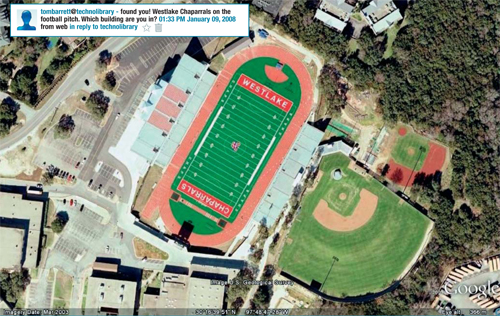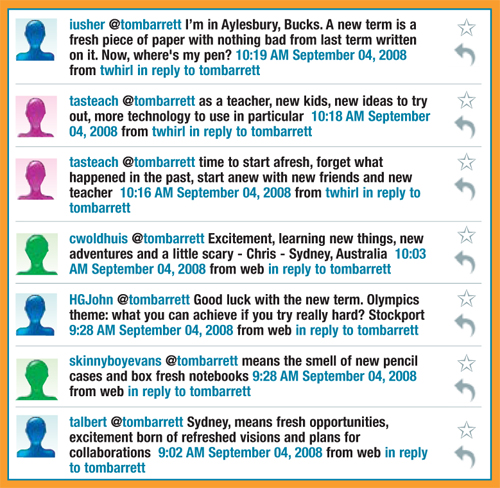Tom Barrett continues on his mission to get the world’s educators inspiring each other in 140 characters or fewer...
Over the last couple of issues we’ve been exploring how to begin building an education network using Twitter – and looking at some of the ways this social networking tool has impacted positively on my role as a primary teacher. In this, the last of my mini-series of features on the subject, I will offer some tried and tested ideas from the chalkface for making practical use of Twitter in lessons. I hope they will inspire you to continue building your own network; and perhaps come up with some tweet-driven activities of your own to pass on to fellow teachers!
Ask those in your Twitter network (your ‘tweeps’) for a small bit of information about where they teach, and then challenge your children to locate the relevant schools using these clues, and the internet. This is a great starting point for pupils when learning how to search using Google Earth or Google Maps. They must seek out visual evidence and verify that the location has been identified – when we tried this, we were able to prove to a teacher in America that we had found her school from the name of the American football team painted on its field!
In this activity the children are not told what to do or how to search, nor are they instructed about what features to use. They are given a real purpose for their investigation, which changes their motivation for the task. They are explorers, not tourists.
tombarrett@technolibrary - found you! Westlake Chaparrals on the football pitch. Which building are you in? 01:33 PM January 09, 2008 from web in reply to technolibrary

The global reach of a Twitter network gives it the potential to work as a wonderful resource for gathering real life perspectives from people in other countries. Why not share these with the children in a class or whole school assembly? For example, Twitter has been buzzing recently with well wishes as the US and UK schools return to a new term at the same time. Last year I invited my network to help contribute to an assembly with their own thoughts about this fresh beginning.
In the assembly I invited the children to explain their feelings and reflections on the first few days of school. We discussed what they were looking forward to, and any apprehensions they had. I then added an international twist, by sharing some of the thoughts from my Twitter network on the subject, finishing with Ian Usher’s reflection that a new term is ‘like a fresh piece of paper with nothing bad from last term written on it’. The youngsters really liked that thought, and it ended the assembly in a positive way.
Try asking your network about different issues affecting the children in your school, both educationally, and in a wider context. Do they agree with school uniform? What does ‘water’ mean to them? Sharing these simple messages will help the children think beyond the four walls of their school and offer valuable insights into life in other countries.

Steve Collis is a languages teacher in a school in Sydney, Australia. Using his own Twitter network he was able effectively to demonstrate to pupils the importance of language learning from a global perspective.
He sent a request asking his tweeps to explain how many languages they spoke and where they were located. With 36 replies from a range of countries he was able to map the data from the responses, and it proved a great discussion point to start his lesson.
As Steve says on his blog his students ‘could see without any doubt that they had just had a conversation with the world’ – you can read more about this lesson at happysteve.com/2009/05/a-class-has-aconversation- with-the-world.html.
To help my Year 5 class understand the language of probability I asked my network to help in our maths lesson. All I asked the tweeps to do was to explain what the likelihood of snow would be where they were for the following day. Many of the responses were from Australia, and so the children and I discussed why they were saying it was so unlikely.
A reply then appeared from a teacher in Scotland saying, ‘quite possible - maybe a 1 in 4 chance? East Lothian, Scotland.’ His use of language offered a great teaching moment for our class.

We focused on his use of the expression ‘a 1 in 4 chance’ and explored how this could be rephrased as a quarter – which naturally led us to the equivalent percentage.
The children had been using five words to describe probability in the main part of the lesson: certain, probable, possible, unlikely and impossible. After reminding them about this I asked pupils to position ‘1 in 4’ or 25% on their own scale and to give a word that best described the chance of snow in East Lothian. It is amazing what a single tweet can do to a lesson.
Many schools have now set up their own class or school Twitter account and invited parents to ‘follow’ the updates. The microblogging service is proving a valuable channel of communication for school communities. It is free to set up, and easy to manage and update. The fact that it is ideal for mobile use means that accessing the information is a breeze for parent communities, too.
School Twitter updates can compliment a blog or website and allow staff quickly to communicate such important news as the cancelled sports day, any delay in the return time of a trip – and if it snows, whether the school is open or closed. A link to the official website could be included in reminders to parents about special events. Naturally, the success of such a system does depend on Twitter-literate parents following the account in the first place – but it would certainly be a good addition to a range of information channels.
There are many great ways to use Twitter, so to pull them all together I’ve been encouraging teachers to contribute to a presentation of ‘interesting ways’ to bring the site into the classroom, which you can view at http://bit.ly/aNCgi. Most of the ideas have already been tried and tested in a real educational setting, and I am sure you’ll find something there to continue to inspire you.
“The global reach of a Twitter network gives it the potential to work as a wonderful resource for gathering real life perspectives”
“Many schools have now set up their own class or school Twitter account and invited parents to ‘follow’ the updates”

Part three
Recently a teacher from Australia visited our school (as a result of arrangements and connections made via Twitter, of course!) He referred to the interactions with his Twitter network as being his most important professional development. I have heard this statement made by many different teachers from across the world, and I also believe it to be true.
With that in mind my final Twitter challenge is a simple one – continue building your Twitter network. Regularly invest some time in making new connections with teachers across the world and use the ideas we have explored over the past three issues… and I am sure you to will come to consider your Twitter network an invaluable resource.
Good luck; and see you on Twitter - @tombarrett - http://tbarrett.edublogs.org
How children react to a moral dilemma may be down to your teaching
Ace-Classroom-Support
5 Ways To Celebrate World Book Day
Ace-Classroom-Support
Easy ways to combat teacher stress
Ace-Heads
